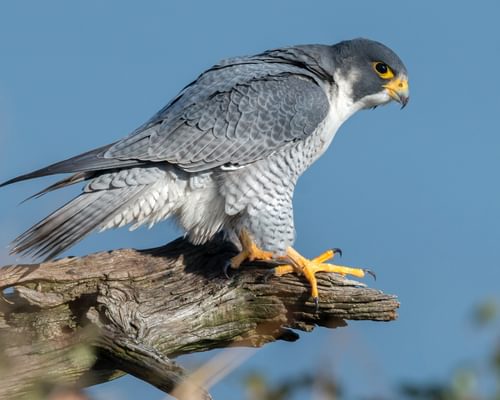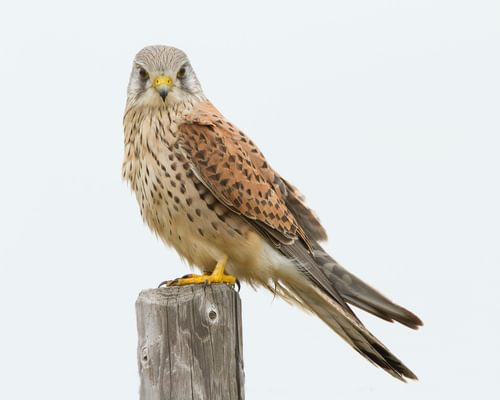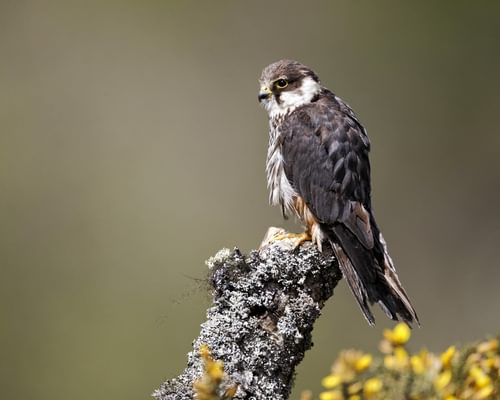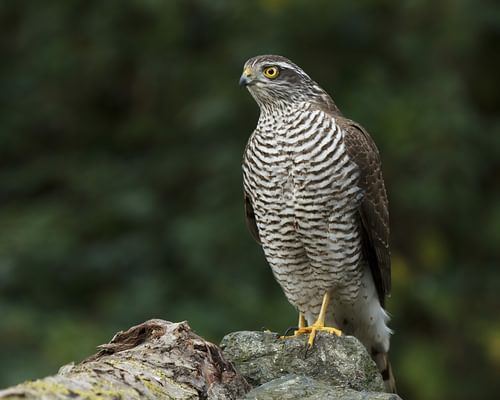Merlin
Least ConcernFalco columbarius
Visual Identification
Appearance
The Merlin is a compact falcon with a stocky build and pointed wings. Males display blue-grey upperparts, while females are brown above. Both sexes have streaked underparts, with males showing rufous barring and females having heavier brown streaking.
Juveniles resemble adult females but have a brown tail with narrow pale bands. All Merlins have a distinctive dark moustache mark and yellow legs, contrasting with their dark plumage.
Size
Length
24cm to 33cm
Wingspan
50cm to 62cm
Weight
125g to 300g
Habitat and Distribution
Habitats
Woodland
Garden
Wetland
Coastal
Urban
Farmland
Grassland
Desert
Tundra
Rainforest
Mountain
Savanna
Distribution
Merlins inhabit many open to semi-open landscapes, including tundra, grasslands, and coastal areas. They breed across northern North America, Europe, and Asia, favouring boreal forests and open moorlands.
During winter, many Merlins migrate south to the United States, southern Europe, and parts of Asia. In the UK, they are year-round residents in Scotland and northern England, with winter visitors in southern regions.
Elevation Range
Sea level to 3,000 meters
Climate zones
Temperate, Subarctic, Arctic
Distribution Map
This map gives you a rough idea of where you might spot a Merlin. The coloured areas show countries where these birds have been seen.
A few things to keep in mind:
- Birds might not be everywhere in the coloured areas, for example, they may be present around the coast of that country
- Where birds live can change with seasons and available food
- This map is quite simple - it doesn't show exact locations
We're working on making our maps even better! Soon, we hope to show you:
- More detailed maps for bigger countries, including state and region
- How birds move around during different seasons
Distribution by Region
Behaviour and Ecology
Bird Attributes
This feature is in beta. We'd love your feedback to improve it!
Share your thoughtsBird Attributes Explained
Our bird attributes system rates various aspects of a bird's capabilities on a scale of 0-100, based on data from field observations, scientific studies, and expert knowledge.
Attribute Categories:
- Agility: Manoeuvrability, speed, and grace in flight or movement.
- Strength: Physical power, often correlating with size and hunting abilities.
- Adaptability: Ability to thrive in various environments or changing conditions.
- Aggressiveness: Territorial behaviour and assertiveness, particularly during breeding seasons.
- Endurance: Stamina, often seen in migration patterns or foraging behaviours.
Understanding the Ratings:
- 0-20: Very Low
- 21-40: Low
- 41-60: Average
- 61-80: High
- 81-100: Very High
Remember, these attributes are relative to other bird species and don't necessarily indicate superiority.
Hover over the icon next to each attribute for more information.
Tap the icon next to each attribute for more information.
Agility
Reflects the bird's manoeuvrability, speed, and grace in flight or movement.
The Merlin is exceptionally agile, capable of swift, low-level flight and impressive aerial manoeuvres. Its ability to catch prey mid-air and perform intricate courtship displays demonstrates remarkable agility for a bird of its size.
Strength
Indicates the bird's physical power, often correlating with size and hunting abilities.
Whilst not the strongest falcon, the Merlin's compact, stocky build provides good strength for its size. It can effectively hunt birds up to its own weight, showcasing considerable power in relation to its small stature.
Adaptability
Represents the bird's ability to thrive in various environments or changing conditions.
Merlins display high adaptability, thriving in diverse habitats from sea level to 3,000 metres elevation. Their ability to utilise various hunting techniques and nest in different environments across their wide range indicates strong adaptive capabilities.
Aggressiveness
Measures the bird's territorial behaviour and assertiveness, particularly during breeding seasons.
Merlins exhibit notable aggression, particularly during breeding season. They fiercely defend territories, engage in aerial disputes, and are bold hunters, often taking on prey close to their own size. However, they're not typically aggressive towards humans.
Endurance
Reflects the bird's stamina, often seen in migration patterns or foraging behaviours.
The Merlin demonstrates good endurance, evidenced by its migratory habits and hunting style. Its ability to maintain speeds up to 40 mph in level flight and engage in persistent aerial pursuits suggests solid stamina, though not at the level of some larger raptors.
Diet
Merlins primarily hunt small to medium-sized birds, such as sparrows, pipits, and sandpipers. They also consume large insects, particularly dragonflies, and occasionally small mammals.
Merlins often catch prey in mid-air, showcasing their exceptional flying skills and agility.
Behaviour
Merlins are agile and swift hunters, often seen flying low over open areas in pursuit of small birds. They frequently perch on exposed branches or posts, scanning for prey.
During the breeding season, Merlins become territorial and may perform impressive aerial displays to defend their nesting areas.
Vocalisation
Merlins have a distinctive, rapid-fire call often described as 'kee-kee-kee' or 'ki-ki-ki'. This high-pitched, chattering vocalisation is commonly heard during territorial disputes or when alarmed. During courtship, males may produce a softer, rolling 'krrrr' sound.
Nesting & Breeding
Merlins typically form monogamous pairs during the breeding season, which varies by region but generally occurs from May to July. They do not build their own nests, instead using abandoned nests of other birds, particularly crows.
Females lay 3-5 eggs, which are creamy-white with reddish-brown spots. The eggs are incubated primarily by the female for about 28-32 days.
Both parents care for the nestlings, which fledge after 25-35 days. The young remain dependent on their parents for several weeks after leaving the nest.
Lifespan
years
The Merlin typically lives for 8 to 11 years.
Like all birds, lifespan can be affected by factors including predation, habitat quality, disease, and access to food sources.
Conservation and Status
Global Conservation Status
While the Merlin is currently listed as Least Concern, it faces threats from habitat loss and pesticide use.
Conservation efforts focus on preserving breeding habitats and reducing the use of harmful chemicals in their hunting grounds. Monitoring programs track population trends across their range.
Birdwatching Tips
- Look for Merlins in open areas near woodland edges
- Observe their rapid, direct flight pattern
- Listen for their high-pitched, chattering call
- In North America, watch for them during fall migration along coastlines
- In the UK, scan moorlands and coastal areas during the winter months
Additional Information
Quick Facts
Other names:
Pigeon Hawk
Family:
FalconidaePredators
Adult Merlins have few natural predators, but eggs and nestlings may fall prey to larger raptors, corvids, and climbing mammals such as martens and squirrels.
Did You Know?
- Merlins can reach speeds of up to 40 mph (64 km/h) in level flight.
- They were historically used in falconry, prized for their ability to hunt skylarks.
- Merlins sometimes hunt cooperatively in pairs, with one bird flushing prey for the other to catch.
Was this bird profile helpful?
Your feedback helps us improve our content
Thanks for your feedback!
Your input helps us improve our content.
Community Experience
Community Ratings
No ratings yet - be the first to rate this bird!
Latest Community Reviews
No reviews yet
Sign in to be the first to review
Community Reviews
Create Your Free Account Welcome Back!
Join our community to rate birds and share your experiences. Creating an account is completely free and only takes a minute. Sign in to your account to rate birds and share your experiences with our community.
Your information is secure and will never be shared.
By creating an account, you agree to our Privacy Policy.
Similar Birds
References
- 1 2 3
website: BirdLife International. 2021. Falco columbarius. The IUCN Red List of Threatened Species 2021: e.T22696453A154505853.
View source



